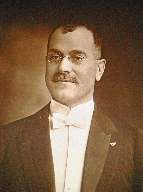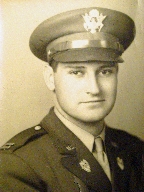
HRAND KRIKOR CHEKIJIAN (a.k.a.) Dr. Henry K. Emerson
Born 1864 (
Son of Krikor Chekijian (1830-1895) who had nine brothers and one sister (Araxi).
They were all born in
Krikor had three sons: Hagop, Hrand and
Gurgen.
We'd like to know the significance of the pin on his lapel in the above image.
Hrand was the first cousin of Hagop
Chekijian (the head of the household in the family photo taken in
Hagop was Krikor’s brother Kevork’s oldest son, the other three
sons of Kevork being Manuel, Nazaret and Hovannes Chekijian - all were born in
Apparently in the 1880's when Krikor’s second
son Hrand was in his early 20's, he emigrated to the U.S. through Ellis Island
via Alexandria, Egypt (where there were other Chekijians at the time) and
adopted the name Henry K. Emerson. This was his name when he graduated from
Cleveland College of Physics and Surgery in
After a brief period of practicing medicine in the state of
"Dr. H. K. Emerson" had a son in 1916 who was named Henry (Hank)
Krikor Emerson. They lived on
One story goes that a patient of Henry's was an "ice-cream man" who
used to bring a cold treat to the doctor in lieu of payment.
Henry was also involved in industrial medicine and he received a badge as a
surgeon for the Los Angeles Fire Department. Apparently Dr. Emerson used to
attend many Armenian picnics in the
He died at the age of 77.

HENRY (HANK) KREKOR EMERSON (1916-1944)
Dr. H. K. Emerson's only child was born and raised in
Hank married Dorothy Mae Wasson, and their son Henry Gregory Emerson was born
on
Less than two years later on
Dorothy remarried Barry Stubbs, who adopted Dorothy’s only
son, Henry Gregory Emerson. They renamed him Gregory Emerson Stubbs. When he
grew up, Gregory founded a law firm in the
HAGOP CHEKIJIAN (1862-1935)
Hagop is the older brother of Hrand (Dr.
H. K. Emerson), also born in Aintab, who immigrated to Montevideo, Uruguay in
the 1930’s with his two sons Aram and Nazaret and had two more sons, Garabed
and Mardiros. They were born in
GURGEN CHEKIJIAN (1868-1940)
Gurgen was the youngest brother of Hrand (Dr. H. K. Emerson) and was also
born in
A FINAL, MISCELLANEOUS NOTE
Kayseri (Caesarea to the ancient Romans) is a town about 100 miles northwest of Aintab, in central Asia Minor. It is the place where
two apostles of Jesus Christ, Mathew and Bartholomew, were beheaded. They are said to be buried at the Sourp Garabed Cathedral
in Kayseri. Kayseri is on a plain at the foot of Mt. Erjias guarded by two perimeter walls, an outer and inner, the outer wall was built in the
11th-12th centuries.
The original Roman Caesarea is just northwest of the current city. Within the walls, there were two Armenian churches St. Astvatsatsin
and St. Sarkis. They were located in places that are dug underground into the hillsides like most of the living quarters in Capadocia and dark,
where people descended into them by wooden ladder. Until the 18th century, there were 500 Armenian families living within the walls.
Some were wealthy merchants and teachers, but most were tailors and cabinet makers, according to the chronicles of Simeon of Poland.
He visited Kayseri around 1615 AD. He said that Armenians who lives within the walls of Kayseri only spoke Turkish or Persian, and that
other Armenians living outside the walls spoke Armenian. This explains why most Armenians from Aintab spoke Turkish - yet they used the
Armenian alphabet to write in Turkish. The Chekijians must have been one of the 500 Armenian families living within the inner walls of
Caesarea.
Being that the outer walls of Caesarea were built in the 11th century, more than likely it was built by the Crusaders as an added defensive
measure, and coupling the fact that Chekijian DNA has migrated to a significant extent to Scotland and Britain, one would lead to the
conclusion that Scot & Brit Crusaders during the 11th-13th centuries intermarried with local Armenians and had their siblings travel back
and settle in Britain and Scotland. In so far as 20% of current population o fsouthern Italy bearing the same Chekijian DNA would
more than likely be from the Roman period, when Armenian and Roman were allies in most part (Armenians and Romans never battled
against each other directly) and several Roman Legions heading to the Middle East and North Africa, had major encampments in Capadocia
and created Caesarea, and being that Capadocia was part of the Greater Armenia at the time, Caesarea would have been populated in
most part by Armenians, who again would have intermarried with the Romans who took back their siblings to what is now southern Italy.
Watch THIS PowerPoint presentation about an amazing discovery in the region.
- The FIRST Chekijian in the U.S.




